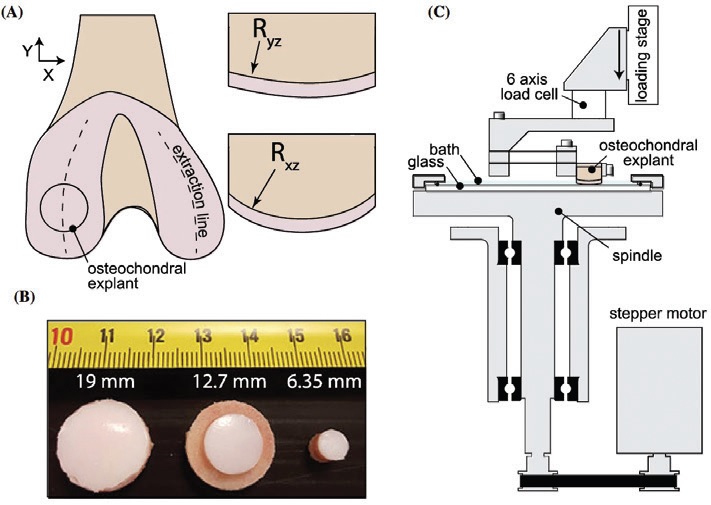Sliding your way to rehydration
Drs. Wilfred T. Tysoe & Nicholas D. Spencer | TLT Cutting Edge August 2019
Articular cartilage loses fluid when compressed, but how does it recover so quickly?
As soon as we put any load on our articular joints (e.g., knees and hips when we stand), fluid is squeezed out of the cartilage, which comprises the sliding surfaces in our joints and consists of about 80% water. This process, which can cause as much as a 50% compression, is one of the mechanisms by which cartilage sustains load and protects itself from damage. It is less clear how the cartilage recovers after loading, which it does at a rate of a few percent per hour, total recovery taking place overnight.
STLE-member David Burris and colleagues Brian Graham, Chris Price and Lucas Ramsey from the University of Delaware, in collaboration with Axel Moore from Imperial College, UK, recently reported results that offer a convincing explanation as to how this recovery may be occurring (
1). Previously they had carried out experiments on real cartilage in a reciprocating tribometer and observed that the sliding itself appeared to induce rehydration. They suggested a possible mechanism for the “tribological rehydration” that was based on the idea that hydrodynamic forces generated in the sliding contact pushed the fluid back into the cartilage.
However, an alternative explanation could be the influence of “reciprocal wedging,” which involves the fluid “wedge” that is produced during sliding becoming compressed upon direction reversal in the reciprocating test rig. The induced squeeze-film effect from this wedge compression also could be a potential rehydration mechanism.
In order to settle the issue, Burris et al. changed their measuring setup to a unidirectional sliding configuration (
see Figure 1), thereby eliminating any possibility of reciprocal wedging. The experiment involved measuring the steady-state values of both friction coefficient and vertical deformation (once the initial elastic effects at a given load had been subtracted) as a function of sliding speed, load, fluid composition and cartilage-pin size. The deformation-versus-speed and µ-versus-speed graphs reproduced the results from the reciprocating study—a clear indication that hydrodynamic effects dominate over any wedge effect (which had been eliminated here)—and also showed that increased sliding speed above 10 mm/s led to a dramatic reduction in both deformation and friction.
 Figure 1. Cartilage samples were extracted from the central region of bovine femoral condyles (a), machined to size (b) and tested in a bath of buffer solution, with or without added hyaluronic acid on a rotary pin-on-disk tribometer (c). (Figure courtesy of Ref. 1.)
Figure 1. Cartilage samples were extracted from the central region of bovine femoral condyles (a), machined to size (b) and tested in a bath of buffer solution, with or without added hyaluronic acid on a rotary pin-on-disk tribometer (c). (Figure courtesy of Ref. 1.)
As expected, higher loads led to greater compression, but higher loads also required higher speeds for fluid recovery, reflecting the competition between the hydrodynamic pressure induced by sliding and the interstitial pressure in the cartilage resulting from loading. Increasing the pin diameter appeared to facilitate the recovery of both deformation and the drop in friction coefficient, consistent with a hydrodynamic mechanism.
The addition of a large polysaccharide, hyaluronic acid (HA), to the tribometer bath, led to a reduction in friction, especially at low speeds, suggesting that it also may interact with the cartilage surface and act as a boundary lubricant. The HA also led to a reduction in the speed at which both deformation and friction began to drop. In other words, the HA, surprisingly, appeared to facilitate the rehydration process. While the increase in viscosity due to HA addition might be expected to reduce the rate of cartilage rehydration by hindering flow into the tissue, the increased hydrodynamic pressure caused by the presence of HA appeared to more than compensate for this effect.
This work moves us a little closer to understanding the mechanism by which cartilage functions so effectively and over such a long time in our joints and hopefully toward approaches to both repairing and imitating this extraordinary tissue at some point in the future.
FOR FURTHER READING
1.
Burris, D. L., Ramsey, L., Graham, B. T., Price, C. and Moore, A. C. (2019), “How Sliding and Hydrodynamics Contribute to Articular Cartilage Fluid and Lubrication Recovery,
Tribology Letters,
67: 46.
Eddy Tysoe is a distinguished professor of physical chemistry at the University of Wisconsin-Milwaukee. You can reach him at wtt@uwm.edu.
Nic Spencer is professor of surface science and technology at the ETH Zurich, Switzerland, and editor-in-chief of STLE-affiliated Tribology Letters journal. You can reach him at nspencer@ethz.ch.